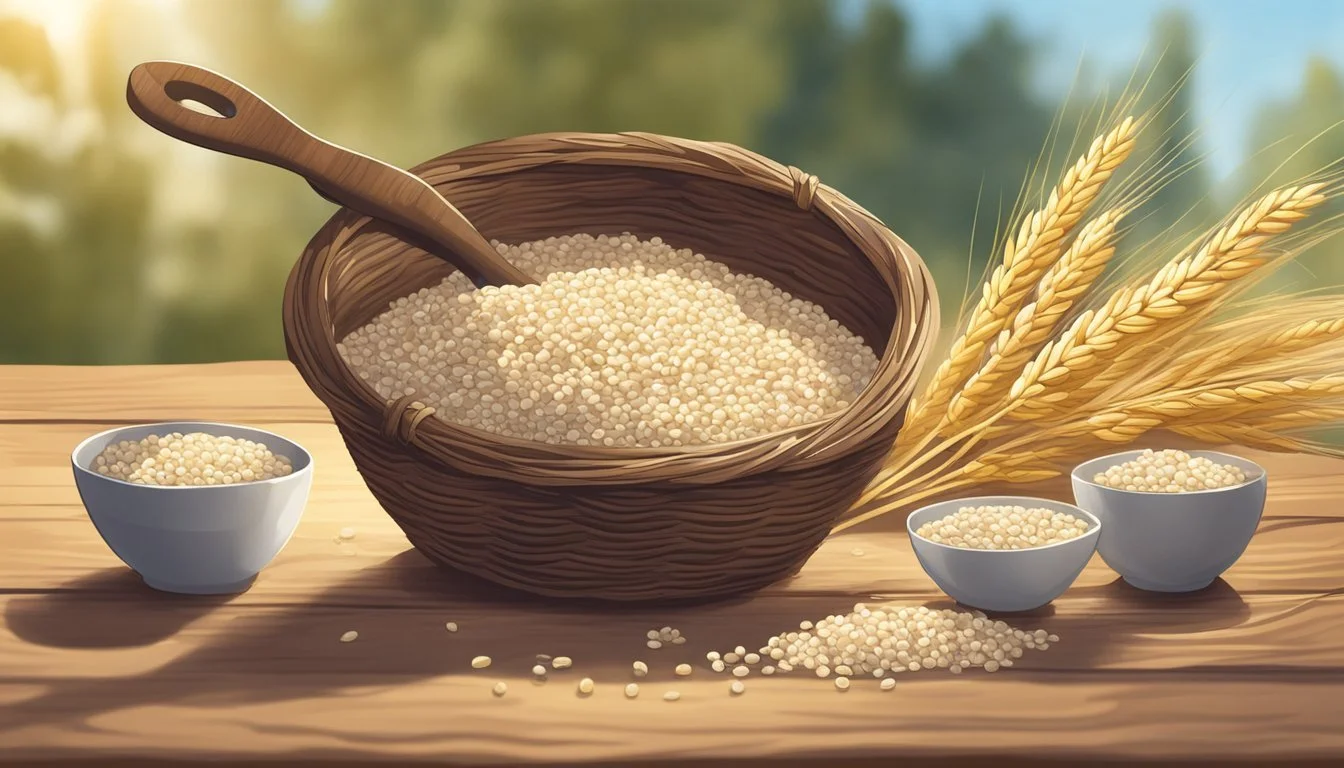Job's Tears Substitutes
Top Alternatives for Cooking and Health
When looking for substitutes for Job's tears, also known as Coix Lacryma-Jobi, several grains can be excellent alternatives. Pearl barley is one of the best substitutes due to its similar chewy texture and nutritional profile. This ancient grain is also rich in fiber and widely used in both Asian and Western cuisines.
Another effective substitute is quinoa. Quinoa offers a comparable texture and is versatile in many dishes ranging from salads to soups. Its high protein content makes it a nutritious choice for those seeking a gluten-free option.
Farro, a type of ancient wheat grain, can be used as well. Although not gluten-free, it brings a slightly nutty flavor and chewy consistency, making it suitable for a range of culinary applications from pilafs to hearty stews.
Botanical Overview
Job's Tears (Coix lacryma-jobi) is a member of the Poaceae or Grass Family. It is known for its grain-bearing capabilities and ornamental qualities. This plant is native to Southeast Asia and has been introduced to other regions, including East Asia.
The plant can be grown as either a perennial in tropical climates or an annual in temperate zones. It features wide, arching blades that give it a distinctive look. The foliage is often described as long-lasting and evergreen in suitable climates.
Job's Tears produces spikes of grain at the end of the warm season. These swell to become the "pearls" or seeds, known as Coix Seeds.
The plant typically grows upright but can arch or cascade, making it suitable for both garden and indoor ornamental use. It has a slow growth pattern but is appreciated for its tall, graceful appearance.
Nutritional Profile
Job’s tears, known for their versatility and nutritional value, are a rich source of several macronutrients, vitamins, minerals, dietary fiber, antioxidants, and amino acids.
Macronutrients
Job’s tears are a good source of protein, containing about 5 grams of protein per 100 grams. This surpasses the protein content of many other grains.
In terms of carbohydrates, Job's tears provide about 65-70 grams per 100 grams, making it a high-energy food.
The fat content is relatively low, roughly 2 grams per 100 grams, predominantly unsaturated fats. This macronutrient profile makes Job's tears a balanced addition to the diet.
Vitamins and Minerals
Job’s tears are packed with essential minerals. They are particularly rich in potassium, which supports heart health, and calcium, which is important for bone health.
Iron is another key mineral present in significant amounts, aiding in proper oxygen transport in the blood. Additionally, Job’s tears contain a variety of vitamins including B vitamins such as B1 (thiamine), B2 (riboflavin), and B3 (niacin), which are crucial for energy metabolism and nervous system function.
Dietary Fiber
A notable feature of Job’s tears is their high dietary fiber content. This grain provides roughly 8 grams of fiber per 100 grams, which supports digestive health and can aid in weight management.
The fiber in Job's tears helps regulate blood sugar levels and can improve cholesterol levels, thus supporting overall cardiovascular health.
Antioxidants and Amino Acids
Job’s tears also contain antioxidants that help combat oxidative stress and inflammation in the body. Key antioxidants found include the B vitamins mentioned earlier, as well as others like vitamin E.
Amino acids, the building blocks of protein, are also abundant in Job’s tears. Essential amino acids such as lysine and methionine are present, contributing to the formation of proteins in the body and supporting various physiological functions.
These components make Job's tears not only a nutritious but also a functional food choice for many health-conscious individuals.
Culinary Uses
Job's Tears, also known as Adlai, offers versatility in cooking through its unique texture and nutritional benefits. From traditional Asian dishes to modern culinary trends, its usage spans a variety of preparations including soups, salads, and desserts.
Traditional Asian Cuisine
In Korea, powdered Job's Tears is popular for brewing a thick, warm beverage. China often uses whole seeds in sweet, tea-like drinks.
The grain adds substantial texture to soups, making them heartier. It's often combined with red beans and mung beans in congee, a type of rice porridge.
Common Dishes:
Korean Yulmu-cha (tea)
Chinese sweet soup with sugar
Savory congee
Preparation:
Soaked in water to soften.
Simmered until chewy.
Contemporary Adaptations
Chefs now incorporate Job’s Tears in trendy and organic grain bowls, salads, and even desserts. The grain's firm bite makes it a great gluten-free alternative in various recipes.
In salads, it pairs well with vegetables like cherry tomatoes, cucumbers, and avocados. For desserts, it's used in puddings or as a cereal topping.
Popular Dishes:
Grain Bowls with fresh herbs
Gluten-free desserts
Preparation:
Cooked in a pot with water until tender.
Drained and tossed with ingredients for specific dishes.
Cooking Techniques
To cook Job’s Tears, it's essential to soak them first, reducing cooking time. Boiling is the primary method, typically taking 45-55 minutes to achieve a chewy texture.
The grains do not absorb all the cooking liquid, so they must be drained before further use. For enhanced flavor, they can be sautéed with ingredients like ginger, garlic, or chili.
Key Steps:
Soaking: Softens the grains and speeds up the cooking process.
Boiling: Requires moderate heat until tender.
Draining: Removes excess liquid before use in dishes.
Enhancements:
Including aromatic spices during cooking.
Mixing with other grains like bulgur.
Cultivation and Harvesting
Job's Tears, a tropical plant, thrives in specific environmental conditions and requires certain cultivation practices. This section provides insights into its growth requirements and harvesting methods.
Growth Requirements
Job's Tears, also known as Coix lacryma-jobi, prefers moist soils and typically thrives in tropical and subtropical climates. It grows well in USDA zones 9 to 10, where it acts as a perennial. In colder regions, it is usually treated as an annual.
Soil Conditions: The plant favors fertile, well-drained soils. Regular watering is vital during its early growth stages. However, once established, moderate watering suffices as the plant develops deeper roots.
Temperature: Ideal temperatures range between 70°F and 90°F.
Sunlight: Job's Tears needs full sunlight for optimal growth. Ensure the planting area receives at least six hours of sunlight daily.
Seeds: Sowing is recommended in the spring after the danger of frost has passed. The seeds germinate best in warm soil conditions.
Harvesting Methods
Harvesting Job's Tears requires timely attention to the grain heads. The plant usually flowers and produces seeds in summer. Allow the seeds to dry on the plant before collecting them.
Timing: Harvesting can start once the seed heads turn brown and dry. This usually occurs in late summer to early fall.
Method: Use a sickle or sharp garden shears to cut the mature stalks.
Post-Harvest: After cutting, hang the stalks in a dry, ventilated area for further drying. Once fully dried, seeds can be manually threshed from the heads.
Proper storage is crucial. Keep seeds in an airtight container in a cool, dry place to maintain viability.
By following these guidelines, cultivating and harvesting Job's Tears can be a manageable and rewarding process for gardeners.
Substitutes and Alternatives
Job's tears can be replaced with various grains and other ingredients, each offering unique textures and nutritional profiles. Choosing the right substitute often depends on the specific culinary need or dietary preference.
Similar Grains
Quinoa and Pearl Barley are excellent substitutes. Both grains have a chewy texture and can absorb flavors well.
Quinoa is notable for its high protein content and quick cooking time. It's suitable for salads, soups, and as a side dish.
Pearl Barley, with its slightly nutty taste, also works well in soups, stews, and salads. It requires a longer cooking time but offers a satisfying chewiness.
Corn and Rice also serve as potential substitutes. Corn, especially hominy, provides a distinctive bite and flavor, making it ideal for hearty stews. Rice, whether white or brown, is versatile, absorbing flavors easily and fitting a wide array of recipes.
Variants for Specific Needs
For those focusing on gluten-free options, quinoa is a top choice due to its nutrient profile and versatility. It's perfect for various dishes from pilafs to salads.
Beans can also be an alternative for those looking for protein-rich substitutes. They fit well in soups, stews, and even salads.
For a pasta substitute, small pasta shapes can mimic the texture of Job's tears. Options like orzo or acini di pepe are suitable, particularly in soups and salads.
When considering calorie content or dietary restrictions, it's vital to choose the substitute that aligns with the specific health or culinary requirements of the dish.
Health Benefits
Job's tears, known for its various medicinal properties, can support digestive health and assist in weight management. Here are detailed insights into these benefits.
Digestive Health
Job's tears are highly beneficial for the digestive system. Studies have discovered that the seeds protect the gastrointestinal tract. For instance, a study published in the Journal of Agricultural and Food Chemistry indicated that these seeds could inhibit the growth of gastric cancer cells in lab settings.
Additionally, Job's tears can help reduce stomach ulcers in animal models. It promotes good bacteria growth in the gut, aiding in digestion. The grain is also gluten-free, which makes it an excellent choice for individuals with gluten sensitivities or celiac disease. This dual benefit of promoting digestive health and being suitable for gluten-intolerant individuals adds a practical advantage.
Weight Management
Job's tears have a notable impact on weight management. Research featured in the journal Life Sciences demonstrated that extracts from Job's tears, when administered to mice, led to significant reductions in body weight, food intake, body fat, and levels of cholesterol and triglycerides. These findings suggest its potential in aiding weight loss.
The seeds are also a good source of dietary fiber, which helps maintain a feeling of fullness, reducing the urge to overeat. This nutrient profile, including higher levels of protein compared to other grains, makes Job's tears a beneficial addition to a weight management regimen.
Purchasing and Storage
When purchasing and storing Job's tears, quality and preservation are key aspects to consider. Ensuring that you buy high-quality seeds and store them correctly will extend their shelf life and maintain their nutritional value.
Selecting Quality Seeds
When selecting Job's tears, seek out seeds that are uniform in size and color. They should have a consistent pearly-white appearance and a smooth texture. Avoid any seeds that appear discolored or shriveled.
Organic options ensure that the seeds are free from pesticides. For convenience, look for reputable online sources such as Amazon. When purchasing in-person, check for packages that are well-sealed to prevent contamination.
Inspect the seeds for any signs of moisture or mold, as these can indicate poor storage or quality issues during production.
Storage Methods
Proper storage of Job's tears involves keeping them in a cool, dry place. Use airtight containers to protect them from humidity and pests. Glass jars are excellent for this purpose, as they provide a secure barrier and are easy to seal.
If storing for an extended period, consider refrigerating or freezing the seeds. Both methods can significantly prolong their shelf life without compromising quality.
Labeling containers with the date of purchase can help keep track of freshness. Keep the seeds away from direct sunlight, as exposure to light can degrade their quality over time. Properly stored, Job's tears can last up to a year without losing their nutritional benefits.
Applications Beyond Cooking
Beyond its culinary uses, Job's tears are also utilized in crafting and hold significant cultural value. This versatile grain finds applications in jewelry making and has historical importance in several cultures.
Craft and Jewelry Making
Job's tears are popular in craft and jewelry making due to their unique shape and natural holes, which make them ideal for stringing. In Korea and Japan, these grains are often used to create necklaces, bracelets, and other decorative items. These crafts are not only aesthetically pleasing but also symbolize good luck and protection.
In other parts of Asia, like Vietnam and Thailand, Job's tears are used to make traditional accessories. Artisans value the grain for its durability and natural beauty, incorporating it into rosaries and amulets. This practice highlights the versatility and timeless appeal of Job's tears in craftwork.
Cultural Significance
Job's tears have played an essential role in various cultures, particularly in China and India. In China, the grain is often associated with traditional medicine and is believed to have health and spiritual benefits. It is used in rituals and as a symbol of resilience and strength.
In India, Job's tears are included in religious ceremonies and are thought to ward off evil spirits. They hold a place in folk medicine for their purported healing properties. The grain's cultural significance extends to Korea, where it is sometimes included in ancestral rites, symbolizing purity and protection.
The use of Job's tears in these cultural contexts reflects its deep-rooted importance in various traditions across Asia.








